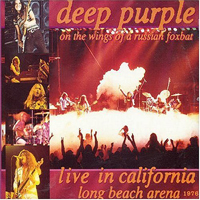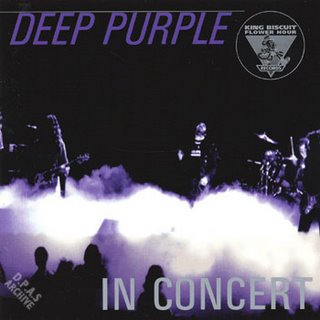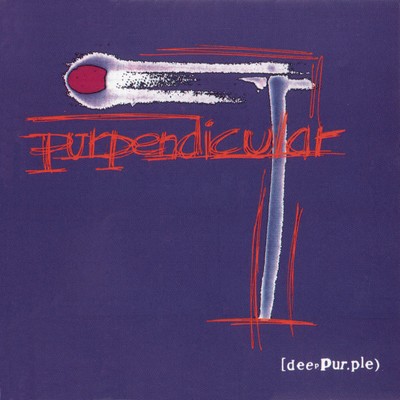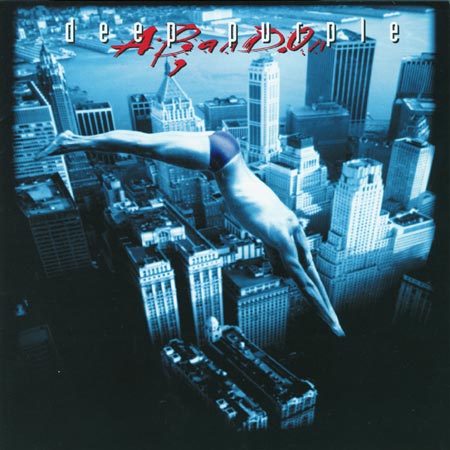

Since their original formation in 1968, the band Deep Purple have assumed many forms. They began as a progressive rock band, then turned into a thundering heavy metal group in 1970. It is that second Deep Purple lineup (referred to as Mk II, and consisting of Ritchie Blackmore, Ian Gillan, Jon Lord, Ian Paice, and Roger Glover) that is regarded as the definitive one, though the band has had a long history of personnel changes, breakups, and regroupings. In one form or another, Deep Purple have always been a major influence on hard rock and heavy metal bands. As of 2018, Deep Purple's eighth and apparently final lineup has gone on a Long Goodbye Tour, although band members have said that a future tour has not necessarily been ruled out.
Like other pages from this site, this page focuses on albums by the band that are out of print. However, this is far from a complete list of out-of-print Deep Purple titles, as countless live albums and compilations have existed and disappeared over the years. Also, many of the titles reviewed on this page have since been reissued.

In 1969, at the tail-end of Purple's progressive rock period and the beginning of their Mk II period, the band collaborated with England's Royal Philharmonic Orchestra to perform a concert at London's Royal Albert Hall. The recording of the concert was released on the album Concerto For Group and Orchestra. The performance consisted of three long pieces written by Purple's classically-trained keyboardist Jon Lord (with lyrics on the second movement provided by vocalist Ian Gillan); each one alternated between the orchestra's classical suites and the band's prog-rock instrumentalism. This was a bold effort in the ongoing debate over the compatibility of rock and classical music, but it doesn't make the best case for it. None of the three movements holds interest from start to finish. The third one comes the closest to being satisfying; the second is the weakest. Though it's a thrill to hear Ritchie Blackmore's guitar playing during the first movement and Ian Paice's drum soloing during the third, one must plod through several minutes of classical noodling to get there in both cases. Note: the album is available on CD in England. That is the best medium for it, since the second movement is not broken up between two album sides, and there are two bonus tracks featuring the group's straightforward performances of "Wring That Neck" and "Child In Time" from the same evening.
Track Listing:
1. Wring That Neck (CD bonus track)
2. Child In Time (CD bonus track)
3. First Movement: Moderato - Allegro
4. Second Movement: Andante
5. Third Movement: Vivace - Presto

By the time the band recorded 1974's Stormbringer, they had changed singers and bassists for the second time. Along with the surviving core of original members Blackmore, Lord, and Paice, the band now included ex-Trapeze bassist Glenn Hughes and future Whitesnake vocalist David Coverdale. Coverdale and Hughes both handled lead vocal duties, and both had impressive abilities. Meanwhile, Purple's music was becoming increasingly rootsy.
Stormbringer was the second and final album recorded by this version of the band (commonly referred to as the Mk III lineup). Contrary to what the album's title might suggest, there is very little heavy metal thunder to be found on Stormbringer. It's one of the band's most laid-back efforts ever. Blackmore's guitar-playing is very blues-based here, and Lord's keyboards often sound extraneous in these rootsier songs. Stormbringer never quite catches fire, but it does contain a riveting blues shuffle ("You Can't Do It Right") and two fairly compelling ballads ("Holy Man", "Soldier Of Fortune").
Track Listing:
1. Stormbringer
2. Love Don't Mean A Thing
3. Holy Man
4. Hold On
5. Lady Double Dealer
6. You Can't Do It Right
7. High Ball Shooter
8. The Gypsy
9. Soldier Of Fortune

The long-standing trio of Blackmore, Lord, and Paice didn't remain unbroken much longer. After Stormbringer was released, Blackmore became displeased with the band's direction, and left to form Rainbow. He was replaced by the late Tommy Bolin, who had previously played with Zephyr and the James Gang. Glenn Hughes had just played on Bolin's solo album Teaser. Bolin was an inspired choice; he was less bombastic than Blackmore, but his versatility and virtuosity was well-suited to Purple's changing sound.
This Mk IV lineup recorded only one proper album, 1975's Come Taste The Band. It was a good album with no bad tracks, but it fell short of greatness. This was no fault of Bolin's; he was an impressive guitarist who could withstand comparison to Blackmore. "Comin' Home" and "Dealer" deliver the hard-rock goods, while several other songs ("Gettin' Tighter", "Love Child") contain intriguing jazz elements bearing Bolin's personal stamp. Come Taste The Band was easily superior to Stormbringer, suggesting that this lineup had the ability to achieve better things over time. But time turned out to be in short supply; Deep Purple soon disbanded, and Bolin died from a drug overdose less than a year later. Deep Purple would later be reborn in 1984 when the Mk II lineup returned.
Track Listing:
1. Comin' Home
2. Lady Luck
3. Gettin' Tighter
4. Dealer
5. I Need Love
6. Drifter
7. Love Child
8a. This Time Around
8b. Owed to 'G'
9. You Keep On Moving

Deep Purple now must rival the Grateful Dead in terms of how many live albums have been released with their name. Many live titles are out of print; on this page, I have reviewed DP live releases which I think are key to their history but are not currently in print. Two of those albums were released shortly after Purple's initial demise in 1976. Made In Europe was recorded during Blackmore's last days with the band, while Last Concert In Japan was recorded with Bolin. Of course, neither should be confused with 1972's Made In Japan.
Made In Europe was recorded with the Mk III lineup, and consists of performances of songs from that lineup's two studio albums. Much better material could have been chosen, but the allotted songs are performed very well, displaying the band as a tightly-rehearsed unit. Blackmore's fiery guitar playing gives the songs a big boost, though the entire band is in good form.
Last Concert In Japan, released in 1977, was a recording of a performance with Bolin at Budokan in December 1975. Unfortunately, Bolin's guitar is largely inaudible on this album. The reason for this is in dispute; some sources say that his playing was hampered by an arm injury, while others say his playing was mixed low so as not to offend Blackmore devotees. In any case, one must wonder what the point was in releasing this album (indeed, in many countries including the U.S., it never was released). The only decent showcase Bolin gets is his performance of "Wild Dogs", from his solo album Teaser. As far as the listener can tell, the band does better with selections from the last three studio albums than with songs from the Mk II years. Bolin's guitar playing (even when you can hear it) has less fire than Blackmore's, and neither Coverdale nor Hughes has as much personality as Ian Gillan. Clearly, this album is a purist's nightmare; it's not recommended for casual listeners either. Coverdale's song introductions are annoying in the extreme. The gentle instrumental rendition of "Woman From Tokyo" consists mainly of an organ solo by Lord, probably intended as a valentine to the titular city in which they were playing. (Note: The 2001 2-CD set This Time Around - Live In Tokyo (CMC International 06076-86312-2) contained this same concert in its entirety and in remixed and remastered form, but without enough improvements to recommend it).
Track Listings:
MADE IN EUROPE
1. Burn
2. Mistreated (interpolating "Rock Me Baby")
3. Lady Double Dealer
4. You Fool No One
5. Stormbringer
LAST CONCERT IN JAPAN
1. Burn
2. Love Child
3. You Keep On Moving
4. Wild Dogs
5. Lady Luck
6. Smoke On The Water
7. Soldier Of Fortune
8. Woman From Tokyo
9. Highway Star

Note: the track listing below is the complete listing from the 1999 2-CD reissue of Nobody’s Perfect. The original vinyl double-LP from 1988 omits “Dead or Alive”. The 1988 cassette omits “Bad Attitude”. The original 1-CD release from 1988 omits “Dead or Alive”, “Bad Attitude”, and “Space Truckin’”.
The Mk II lineup (Blackmore, Gillan, Lord, Paice, Glover) reunited in the mid-‘80’s and recorded two studio albums. The live album Nobody’s Perfect from 1988 was recorded during various American and European dates from this lineup’s 1987 tour in support of the House of Blue Light album. The majority of the song selections are from the lineup’s early-‘70’s glory days, with up to five selections (depending on the physical format) from their mid-‘80’s albums, plus a live-in-the-studio rendition of the Mk I hit “Hush”. Nobody’s Perfect is not a bad display of musicianship by any means; it’s hard not to be impressed by “Child In Time” and “Lazy”. But the album suffers in comparison to the quintet’s classic 1972 live set Made In Japan, and it invites that comparison by offering less-gripping performances of almost all of the same songs. The newer songs sound okay if you like the studio versions, although the nearly-four-minute intro to “Knocking at Your Back Door” seems out of place. A few surprises: the band somehow incorporates a piece from “Jesus Christ Superstar” into “Strange Kind of Woman”, and “Woman From Tokyo” somehow turns into a cover of Buddy Holly’s “Every Day”. And it’s amusing to hear Gillan not take “Hush” too seriously, although this “live jam” version may make you yearn for the original.Track Listing:
1. Highway Star
2. Strange Kind of Woman
3. Dead or Alive
4. Perfect Strangers
5. Hard Lovin’ Woman
6. Bad Attitude
7. Knocking at Your Back Door
8. Child In Time
9. Lazy
10. Space Truckiní
11. Black Night
12. Woman From Tokyo
13. Smoke on the Water
14. Hush
![]()
A few years after the Mk II lineup reunited, a rift developed between Blackmore and Gillan, and Gillan left the band. He was replaced by Joe Lynn Turner, a former lead singer for Blackmore's Rainbow.
The only album recorded by this Mk V lineup was 1990's Slaves And Masters. It's a refined, easily-digestable hard rock album, the type you might expect from Foreigner, Kansas, or (you guessed it) Rainbow. On that level, Slaves And Masters is a pretty good album, highlighted by a few exciting piledrivers ("Fire In The Basement", "Wicked Ways") and the more graceful "Love Conquers All", which recalls Purple's prog-rock roots. A "Deluxe Edition" of Slaves And Masters was issued in 2015, featuring all of two bonus tracks: "Slow Down Sister" and a radio edit of "Love Conquers All".
Track Listing:
1. King Of Dreams
2. The Cut Runs Deep
3. Fire In The Basement
4. Fortune Teller
5. Truth Hurts
6. Love Conquers All
7. Breakfast In Bed
8. Too Much Is Not Enough
9. Wicked Ways

The last time that the Mk II lineup ever reunited was in 1993, for an album titled The Battle Rages On.... That title presumably refers to the personal battle between Blackmore and Gillan, both of whom quit the band shortly after the recordings. But there isn't much rage to be found in the curiously unexciting songs. Though it's nice to hear Blackmore's guitar licks and Gillan's quirky vocals together again on the same album, the thrill is completely gone. When this quintet appears to have stolen a song title from the sleaziest depths of the Kiss repertoire ("Lick It Up"?), it is clear that inspiration was running very low. This is definitely not the way this lineup ought to be remembered.
Track Listing:
1. The Battle Rages On
2. Lick It Up
3. Anya
4. Talk About Love
5. Time To Kill
6. Ramshackle Man
7. A Twist In The Tale
8. Nasty Piece Of Work
9. Solitaire
10. One Man's Meat



A consumer alert is in order: there is a Purple live album that has been released under different titles in different countries. In Europe, the double-CD is known as On The Wings Of A Russian Foxbat (album cover is pictured above left); in the U.S. and Canada, the exact same set has been released under the titles King Biscuit Flower Hour Presents Deep Purple In Concert in 1996 (album cover pictured above right) and Live at Long Beach Arena in 2010. So don't make the mistake of purchasing more than one copy of the same album, okay? (To confuse matters further, a truncated single-disc version is currently available as Extended Versions, packaged as part of BMG's Encore Collection. Buyer beware!). Now that we've cleared that up, this album contains a recording of the Mk IV lineup (the one with Tommy Bolin) performing at California's Long Beach Arena in February 1976, along with two bonus tracks that were recorded in Springfield a month earlier. That strange European title originally belonged to a U.S. bootleg of the concert. Though it's no Made In Japan, this album is everything that Last Concert In Japan should have been. It is a good showcase for Bolin and the rest of the lineup (although Coverdale is not at his best), as you hear them play songs from Come Taste The Band as well as earlier material. Bolin even got to strut his stuff (in a fairly disciplined manner) on a lengthy solo. "Getting Tighter", "Love Child", and "Stormbringer" are especially well done. Fans of Come Taste The Band will enjoy this the most, though Bolin does a good job of filling Blackmore's shoes when performing earlier material.
Track Listing:
1. Burn
2. Lady Luck
3. Getting Tighter
4. Love Child
5. Smoke On The Water (inc Georgia On My Mind)
6. Lazy
7. The Grind
8. This Time Around
9. Tommy Bolin solo
10. Stormbringer
11. Highway Star (inc Not Fade Away)
12. Smoke On The Water (inc Georgia On My Mind) -- version 2
13. Going Down
14. Highway Star (inc Not Fade Away) -- version 2


In the mid-'90's, Purple was on lineup number seven. Gillan had returned to the fold, while Blackmore was replaced by Steve Morse, the versatile guitar virtuoso who formerly played with the Dixie Dregs and Kansas. Morse fit into the band surprisingly well, bringing his own brand of musicianship to the table instead of trying to emulate Blackmore. Morse's playing made an immediate impression on the 1996 album Purpendicular, helping to reinvigorate the band's sound and showing solid chemistry with Lord, Glover, and Paice. This album recalls prog and metal sounds of the '70's and '80's, but the band didn't seem to be trying to duplicate their older material so much as create a newer sound in the same basic direction, with a guitarist who had a mind of his own. The band's production brings the songs through loud and clear without letting any of them become stodgy. Purpendicular was an encouraging return to form for Purple, and was possibly the band's most solid and sophisticated studio effort since the '70's.
Track Listing:
1. Vavoom: Ted The Mechanic
2. Loosen My Strings
3. Soon Forgotten
4. Sometimes I Feel Like Screaming
5. Cascades: I'm Not Your Lover
6. The Aviator
7. Rosa's Cantina
8. A Castle Full Of Rascals
9. A Touch Away
10. Hey Cisco
11. Somebody Stole My Guitar
12. The Purpendicular Waltz
13. Don't Hold Your Breath (hidden bonus track)

Live At The Olympia '96 was an "official bootleg" released in European and Asian markets, recorded at the Paris venue in June of that year. It showcased the same Mk VII lineup -- Gillan, Morse, Glover, Lord, and Paice -- which recorded Purpendicular. The 2-hour-long 2-CD set almost resembles a fan club CD in both its packaging and presentation: the CD booklet is full of fan-taken photos, and the album was given no edits or overdubs whatsoever, making it an album that will be mostly appreciated by diehard fans. But those fans will like it just fine. The band had a field day at this show, playing half-a-dozen eclectic songs from Purpendicular and seven Mk II classics (including the then-obscure 1972 B-side "When A Blind Man Cries", which the band reportedly never performed live with Blackmore). Their playing is impressive throughout, demonstrating that Morse's chemistry with the band was every bit as strong as it seemed on the album. "Maybe I'm A Leo" and "No One Came" are particularly good examples of how well Morse could adapt to the older material. "Speed King", appropriately enough, gives Morse the most room to strut his stuff.
Track Listing:
DISC 1
1. Fireball
2. Maybe I'm A Leo
3. Ted The Mechanic
4. Pictures Of Home
5. Black Night
6. Cascades: I'm Not Your Lover
7. Sometimes I Feel Like Screaming
8. Woman From Tokyo
9. No One Came
10. The Purpendicular Waltz
DISC 2
11. Rosa's Cantina
12. Smoke On The Water
13. When A Blind Man Cries
14. Speed King
15. Perfect Strangers
16. Hey Cisco
17. Highway Star


The 1998 album Abandon was the second and final studio album by the Mk VII lineup, and the last one to feature original keyboardist Jon Lord. This album had less art-rock grandeur than Purpendicular, opting instead for a heavier rock sound that is often reminiscent of the band's Mk II glory days -- especially when they convincingly re-record their 1970 metal song "Bloodsucker" at the end. But contrary to its title, Abandon is a very disciplined hard rock album. Even when the band rocks their hardest on songs such as "Watching The Sky" and "'69", or display the most attitude on "Any Fule Kno That" and "She Was", they never let the train go off the rails. Abandon is a satisfying album, varied by the unexpected guitar tunefulness of "Fingers To The Bone", and the blues-based "Don't Make Me Happy".
Track Listing:
1. Any Fule Kno That
2. Almost Human
3. Don't Make Me Happy
4. Seventh Heaven
5. Watching The Sky
6. Fingers To The Bone
7. Jack Ruby
8. She Was
9. Whatsername
10. '69
11. Evil Louie
12. Bludsucker

In 2002, Jon Lord retired from Deep Purple, a decade before his passing in 2012. He was replaced by Don Airey, a journeyman keyboardist who had played usually brief stints in numerous heavy metal acts -- including Rainbow and Whitesnake -- during the three previous decades. As of 2018, Airey is still a member of Deep Purple.
The 2003 album Bananas was the first studio album recorded by the Mk VIII lineup, consisting of Airey, Gillan, Glover, Paice, and Morse. The album was produced by the Detroit-based Richard Bradford, who had recently worked with the likes of Kid Rock and Uncle Kracker. Bradford brought a fresh perspective to the Deep Purple sound, adding touches of '80's-style soul, especially to tracks such as "House Of Pain", "Razzle Dazzle", and "Doing It Tonight". The mixing favors Gillan's lead vocals more than usual, perhaps a bit too much on some tracks, but it does give immediacy to many of the songs; the straightforward rock ballad "Haunted" features a surprise guest appearance by Beth Hart on background vocals. Airey was certainly up to the difficult task of replacing Jon Lord; on "Sun Goes Down", "Silver Tongue", and the title track, Airey's playing could easily be mistaken for Lord's, which ensured a smooth transition for the band. On some other tracks ("Walk On", "I Got Your Number", and the tranquil ballad "Never A Word"), Airey also proved himself able to forge his own identity. The closing instrumental "Contact Lost" was Morse's tribute to the seven astronauts who died in the space shuttle Columbia disaster that year. Bananas was a fine addition to the Purple canon, and was a good start for the Mk VIII era -- but, seriously, who was responsible for the terrible cover art?
Track Listing:
1. House Of Pain
2. Sun Goes Down
3. Haunted
4. Razzle Dazzle
5. Silver Tongue
6. Walk On
7. Picture Of Innocence
8. I Got Your Number
9. Never A Word
10. Bananas
11. Doing It Tonight
12. Contact Lost
See also Tommy Bolin , Velvet Underground
Home
Yes, it's all in purple.
— Discogs (@discogs) July 24, 2018
Deep Purple classics set for purple vinyl release via @loudersound -->https://t.co/uP4ovbhpSc pic.twitter.com/Gxb5SKBCLE